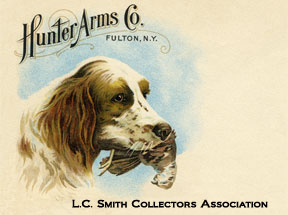|
Evaluation at a gun shop or gun show should be undertaken only with the permission of the seller. If the seller refuses disassembly, walk away! Consider carrying a small tape measure, magnifying glass, chamber length rule, choke gauge, short wooden dowel (to tap the barrels), and snap caps in a zip pouch.
- Are there cracks or chips in the wood? Look carefully at the apex of the locks and at each of the four 'fingers' of the head of the stock? See http://www.picturetrail.com/sfx/album/view/17090409
- Is there evidence of previous repair to the wood?
- Is the level of the wood lower than that of the metal? This would suggest previous wood refinishing.
- Does the metal or wood appear refinished? The amount of wear on the barrel blue, case colors, checkering, engraving, and the stock should match. There should be more 'carry wear' at the bottom of the receiver.
- Has the checkering been re-finished? This may have been done to hide evidence of a previous crack repair.
- What is the length of pull from the front trigger (or Hunter One-Trigger) to the middle of the butt plate? L.C. Smith shotguns could be special ordered, but if less than 14" (including the butt plate) the stock may have been cut. A 14" LOP to the end of a replacement pad suggests a cut stock.
- Is the butt plate or pad original? See http://www.lcsmith.org/faq/recoilpad.html and http://www.picturetrail.com/sfx/album/view/15656750
- Is the forearm loose?
- What percent of case colors remain? See http://www.picturetrail.com/sfx/album/view/12588446 Is the engraving on the receiver and lock plates sharp? If not, or if the case colors are much stronger than what would be expected in light of the over-all condition of the gun, the gun may have been re-case colored.
- What percent of the bluing remains? Is the lettering sharp? If not, the barrels have likely been reblued.
- Are the screws damaged? Damaged screws mean previous disassembly by someone without the skills to do so.
- Is the top lever right of center? Left of center suggests a worn rotating bolt. Does the top lever stay in the open position when the gun is open? Does it snap to the closed position forcefully?
- Is there movement between the barrel and receiver with the gun closed and the forearm removed?
- Is there sideways movement between the barrel and receiver with the gun open?
- Does the gun operate properly? Do the ejectors work with equal force? Does the safety work? Does the safety reset after opening the gun? If a 3-position safety, it should remain off safe when in the rear position.
- Are the trigger pulls light, crisp, and equal? (ONLY pull the triggers with permission, on snap caps, and be sure to open the gun to recock the hammers before disassembly.)
- Does the serial number on the receiver, barrels, and forend iron match?
- What is the length of the barrels? Anything but exactly 26, 28, 30, or 32" would be a cause for concern.
- What are the chokes? The length of 16 and 20 gauge chokes should be 1 1/2 to 2 inches with a very short parallel section at the muzzle. 12g choke should have a 1 9/16" taper segment with a 1" parallel segment.
- Is there pitting in the barrels? Are there any dents or bulges? Ask the seller the bore size (for evidence of previous honing) and the wall thickness. Have the forcing cones been lengthened? Measure the chamber length. Unless special ordered, a 12g chamber should be 2 3/4". Hunter Arms Company lengthened the 20 gauge chambers from 2 1/2" to 2 3/4" in 1936. L.C. Smith and Fulton 16 gauge guns manufactured as late as 1940 may still have 2 9/16" chambers.
- Hold the barrels by the lumps and lightly strike them over the entire length with your wooden dowel (or pencil.) They should give off a bell-like tone. If they clank, or if you hear a rattle or feel a vibration, the ribs may be coming loose. Proper repair may cost several hundred dollars. Look up and down the length of the top and bottom ribs with your magnifying glass for separation or a local area of rust.
- Is there any pitting or corrosion of the exterior metal surfaces? If so, it may well look worse on the inside!
- Has the gun been personalized with numbers, initials, etc.?
- There should be slightly more case color on the water table and breech face than the locks. Are there pits around the firing pin holes or shell rim indentations? Are firing pin bushings present (on a gun made prior to about 1906) and are they cracked? Are the bushing slots damaged? Is the bushing set screw in place?
If you have questions about the possibility of a cut barrel or an upgraded gun, a LCSCA Research Letter can confirm the original configuration If possible, ask the seller to meet you at a gun club so you may shoot the gun. Do NOT fire a gun received from an internet seller without the seller's permission.
ALWAYS expect a 3 day 'for any reason' return privilege. If returned, you will be expected to pay for the return shipping and insurance cost.
If a gun is reported to be of historical significance and arrives without the claimed provenance, send it back immediately.
The best preparation prior to the purchase of a vintage L.C. Smith is to beg, bribe, or pay an experienced LC collector to accompany you. This may prevent your making a many hundreds or thousands of dollars mistake. And most of us enjoy spending some other fella's money!
Always have the shotgun inspected by a competent double gun gunsmith before shooting it. More information may be found at "Is my shotgun safe to shoot?"
COPYRIGHT
L.C. Smith Collectors
Association 2015
Updated 02/17/2015
|

